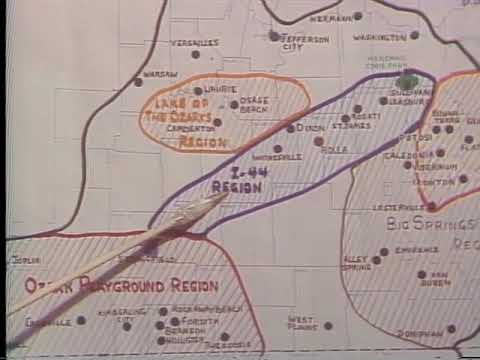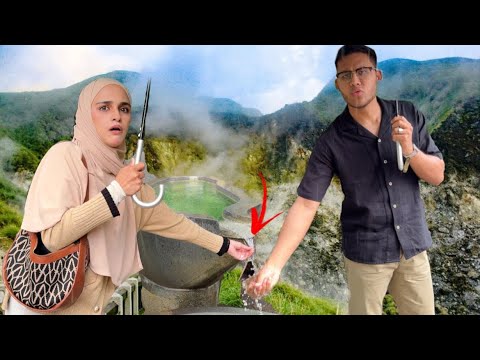Land and Life in the Ozarks--Ozarks Tourism and Recreation Industry

(dulcimer music playing) [Announcer] The Southwest Missouri State University Department of Geography-Geology presents Land and Life in the Ozarks. This course is one of several units of study offered in Ozark Regional Studies at SMSU and is designed to enhance appreciation of the cultural heritage of this region. [Rafferty] The lecture today deals with an important aspect of the Ozark economy--the tourist and recreation industry. In today's lecture I want to cover three points--first,
the location of the Ozarks with reference to its tourist market, then I'll talk about the economic importance of the tourist recreation industry focusing primarily on Missouri where data is available. And then we'll do a reconnaissance of the major tourist and recreation attractions in the Ozark region by tourist recreation region as outlined in the text. By way of perspective I should I think mention that the recreation industry really began before the turn of the century in the Ozarks. In the 1880s and 1890s a number of health spas were opened in the region. This was a time when springs and spas were popular in the United States. It seemed that each spring virtually in
the United States tried to ape the tremendous development at Saratoga Springs in New York. I suppose the most successful of these spas was Eureka Springs in Arkansas and in this slide we see an early view of Eureka Springs. Really I think this picture was taken in the 1930s, but you can see some of the bath houses in the downtown area, and of course a large and rather elegant hotel was built at Eureka Springs. The railroads of course brought people into these resorts and float fishing became popular on the White River and on the James River, before the White River was dammed and before the James River was polluted. The real era of tourist development began in the 1920s when the automobile which, if we can see the next slide, I managed to find an old picture of the open touring car in the Ozarks, but the automobile opened up the area and as roads were improved of course tourism became important. The limiting factor, of course, was the small number of good roads that they.
that the tourists could travel on. Next I'd like to talk a little bit about the Ozark tourism resource base in relation to the market area. The Ozarks is the only hill district in the midsection of the United States and this is important. Because for the flatlanders around the Ozarks it's a
long ways to travel to a similar location. It's a long ways back to the Appalachians in the east, and quite a distance farther to the Rocky Mountains to the west. If we could have the next slide then, this is a map that shows the location of national parks and national forests in the United States. You've seen it before but you can see that the Ozark region is really the only area where a lot of public land is available and it's close to large population centers too. So we're talking about 800 miles to the east to find similar kinds of open land, and likewise you all the way to the Rocky Mountains to the west.
In the next slide we see the Ozark region in relation to major cities. Within a day's drive, and here on this map, you see Kansas City, St. Louis, Tulsa in the southwest, but within a day's drive are cities like Chicago--fairly convenient days drive to the Ozarks--Little Rock to the south, Memphis, Oklahoma City, Wichita, Topeka, Dallas/Fort Worth, so a large population potential market at least around the Ozarks. Now as far as the economic importance of the Ozarks of tourism and recreation to the Ozarks, it's difficult to get data that pertains to the Ozarks, that the reason being is that nobody bothers to collect it for the Ozark region per se. State tourism commissions collect data on tourists, and surprisingly they really weren't that interested in doing much research until fairly recent times.
The best data that I could find by writing to the tourism commissions and in the various states in the Ozarks came from Missouri. Prior to, that is in former years, the tourism commissions functioned primarily as information agencies and advertising agencies of the state. But I think we can extrapolate some of the data from Missouri and make it apply to the Ozarks. If we can have the next slide we see that the origin of tourists in Missouri comes from states adjacent to it. In fact Missouri is her own best customer. 40.7 percent of the tourist visitors in Missouri are
Missourians. But I think if you look at this map a little in some detail you'll see that the largest numbers are from states with large populations such as Illinois, which provides 15 percent of the total. But then on the other hand you have states such as Kentucky and Tennessee which supply fewer visitors because they have similar recreational resources. There's really
no reason for a Kentuckian or Tennessean to come to the Ozarks for lakes and hills because he has the same type of resources available in his home state. Likewise on the other hand Kansas which had has a smaller population has no tourist recreation resources similar to the Ozarks, so they send a substantial percentage of the visitors to the state of Missouri and presumably most of them or many of them at least go to the Ozark region. This graph that you're looking at now was compiled by the federal government and it shows the demand, projected demand, for various types of tourist recreation activities. The three stages on each graph there or each line represents the level of recreational use in 1960, in 1976, and then projected to the year 2000. And just going from the top and without
putting in figures, we see, I'll just read the categories from the top--driving for pleasure, then swimming, the next category is outdoor sports, then picnicking, fishing, hunting, camping, and boating. I think if you look at the graph in each case you see that by the year 2000 the usage of in each of these categories will have at least doubled and sometimes tripled. Well what this means, I guess, is that since the Ozarks has good tourists or good resources in these categories, the future for tourism and recreation is apparently bright over the long run. In the next slide we see statistics which don't show up all together good here.
In Missouri there were 28,800,000 visitors or travelers in Missouri during 1974. This is the most recent data that I could obtain. Now the statistics for their expenditures are impressive. The average tourist in Missouri spent $16.50 a day.
The average stay was four days, and the group or the family average size was three. Well if you do a little multiplication $16.50 times four days times three people, that's $187.50 per tourist visit by a family visiting the state. In the next slide we see that the gross sales from tourism is now over $2 billion in Missouri. Now I would assume that much of this is in the Ozarks region because that's where a lot of the tourist attractions are found. Notice that the increase since 1972 is substantial.
And this is a growing part of the sector of the economy, and perhaps partly responsible for the population growth that has occurred in the Ozarks. In the next slide we see some interesting statistics as to how the tourist dollar is spent. It is spent or spread fairly widely. Transportation accounts for 36.4 cents of the tourist dollar that is spent; food, 21 cents; lodging, 17.5 cents; gifts, 6/10 of a cent; entertainment, 6.3 cents of every tourist dollar; and incidentals which would include I suppose fishing equipment, boating equipment, and hunting equipment, and so on, 18.4 cents of the tourist dollar. The next slide shows that out of state
visitors spent $900 million of the $2 billion that were spent in the state. Now this represents new money which does stimulate the economy in secondary industries and services, or I guess what an economist would refer to as a basic tourism and then it is a basic industry to the region. Then so much for the importance of the tourist recreation industry. Next I'd like to turn to the recreation regions of the state. If we can look at the map,
I'll point out, this is the same map that is in your text and I'll be looking we'll be looking at a series of slides, I wanted to point this out on the map before we start into the slide so by way of orientation. I have identified tourist recreation regions as areas of concentration of tourist activities and recreation activities. I've identified five of these regions in the Ozarks and certainly they don't include all of the tourist and recreation attractions, but they represent concentrations of these activities. The first that we'll be looking at is the Interstate 44 region where a number of tourist attractions have been developed along the interstate. It's not that the attractions are so spectacular; there are some interesting ones there, but simply the volume of traffic here is a major factor in creating this tourist recreation area. The next one we'll look
at is the Lake of the Ozarks region, and of course the Lake of the Ozarks is the focus for this well-established tourist recreation region. The largest of the regions we'll look at then, the third one, is the Ozark playground region which includes not only some large cities such as Springfield and Joplin, but its main focus of attraction is in the lake district, including lakes like Bull Shoals and Taneycomo and Table Rock and Beaver and Grand Lake of the Cherokees in Oklahoma and other lakes. Then we'll look at the Big Springs area which is a developing tourist recreation area in the interior Ozarks, and then finish up with the St.
Francois region, which includes the St. Francois Mountains, the old lead belt, and Ste. Genevieve. I have some shots of developing tourist recreation areas such as Dogpatch and the area around Mountain View in Arkansas. If we have in the first slide we see here the first of the slides that in the I-44 tourist recreation region. This is Meramec Caverns. Inside Meramec Caverns is one of the more spectacular attractions is what's known as the stage curtains, interesting cave travertine. This next picture you're looking
at now is the jungle room in Meramec Caverns, also has some interesting stalactites and stalagmites. This material is simply referred to as drip stone or cave travertine. Nearby is the Onondaga cave. This is a shot of the lily pad room in Onondaga Cave.
And the next one is the shot of the cathedral hall in Onondaga Cave. Of course these are major attractions in that area. Then if we can look at the first slide for the Lake of the Ozarks region. One of the major attractions in the Lake of the Ozarks region is simply its rugged terrain, and there's abundance of open space and wooded hills and steep bluffs such as you see along the meander loop here in the Gasconade River. And in the fall of the year, plenty of good hunting. During deer season this region attracts many hunters from Kansas City and St. Louis and even out of state hunters. In the spring we see here a shot of Bennett Springs opening day. It's a
trout hatchery, and of course the sport fishermen are out in full strength during the early spring. In the next slide we see Bagnell Dam, which is really the key to this whole tourist recreation region. The dam was constructed in the late 1920s, and of course the lake provides the focus for much of the tourist development. One of the most elegant of the tourist recreation resorts on the lake is Tan-Tar-A, and here we see a view of Tan-Tar-A. It's a planned tourist recreation development and in the next picture we see a
rather interesting picture of this at night. Nearby are country music halls, gift shops, and motels, amusement parks, which really make us 54 Highway a tourist strip development, which in some respects detracts from the beauty of the region. Here we see the state capital at Jefferson City which is outside the Lake of the Ozarks region, but close by and annually this attracts a number of tourists to see the capital and the city of Jefferson City. In the next slide we see another of these outlying tourist attractions. This is at Hermann, Missouri, which is a center for German settlement and here we see people dressed in the local, or in the native costumes of the Germans. The town has
interesting architecture and the old wineries are open during the Maifest and the Oktoberfest. The first of the slides for the Ozark playground association is a scene of in the National Cemetery at Springfield. Springfield is sort of the gateway to this region, and it has a number of attractions the National Cemetery of course is where the soldiers who were killed at Wilson's Creek battle in the Civil War are buried. The Wilson Creek Battlefield National Park is south and west of the city. Spring is a good time
for a visit to this area and because the dogwood and redbud are in bloom during this season. Likewise in the fall of the year a number of, hundreds really, hundreds of tourists visit this section of the state because of the fall colors particularly blending in with the glade lands. Camping and outdoor activities abound and there are good facilities for group camping such as this scene you see here of Camp Arrowhead near Marshfield, but church camps are also very numerous. The large springs such as the one that we see in the next slide at Roaring River are not only scenic attractions but also they're good camping locations and a great location for sport fishing at the trout hatchery there. The lakes are the focus for many of the
attractions, and in this next slide we see a view of Table Rock but also the other lakes in that vicinity are major attractions, including the lakes in Oklahoma. I suppose the outstanding attraction of this area is Silver Dollar City, which we see in the next view. This is an aerial view and the area in the city has been expanded considerably since this time. In the same area is Shepherd of the Hills farm and several country music halls and a tourist strip development on Highway 76 between Silver Dollar City and Branson. At Silver Dollar City we see several traditional practices or occupations in the Ozarks that have been preserved. It's developed
as a midwestern Williamsburg or on that theme. Wagon manufacturing is another of the crafts that have been preserved at Silver Dollar City. In the next slide we see Hollister which is located on Taneycomo Lake across the lake from Branson. It was one of the towns that was established after
Powersite Dam was built in 1914. Has the English half timber design on the buildings. There are some sort of off-beat tourist attractions. The mine dumps in the tri-state district are locations that amateur geologists and history buffs enjoy visiting. Seems that each town has some attraction in the summer months. One of the more unusual ones is the snake hunt at Chadwick.
Mostly they catch copperheads and sometimes if they're short of snakes they borrow a few, import a few, from Oklahoma. Western diamondbacks are not native to the area but they do show up in the attraction there. But no one really cares because, as you see in the next picture, there's plenty of local country music and ice cream, and the politicians are out gathering votes and everyone has a good time. Here we see one of I suppose somewhat controversial tourist attraction. This is the Christ of the Ozarks at Eureka Springs, Arkansas. Nearby is an outdoor pavilion where the Passion Play is enacted.
The region also has a number of attractive mills such as you see here at Riverdale on the Finley River, a favorite place for tourists to visit not only for the scenery, but for the water that's there for swimming and for fishing. In the Big Springs area in the interior Ozarks, I suppose the most popular sport is the float trip. And here we see canoes going down the Jacks Fork. The Jacks Fork and Current River have been set aside as part of the National
Scenic Riverways as has the Buffalo River in Arkansas. This is a controversial move. Many of the local residents feel that the area would have been preserved better had it been retained under private control. These interior Ozark streams are quite attractive, and in the next slide we see there's plenty of room for camping and the fishing isn't bad and cooking fish over an open fire attracts a lot of visitors to the area. They're good swimming streams and here we see some visitors from Kansas enjoying the tremendously cold water at Blue Springs on the North Fork River. They make good family streams because the rivers, they do have the riffles and they're fun to run but they're safe and you can walk out of them; in most locations they're quite shallow for the most part. This area is being developed now and in the next slide we see the moonshine
still that the Park Service has established at Alley Springs. And this is drawing attractions, nearby is the bluegrass festival, which you see a sign here, that this takes place around the Fourth of July, so the area is beginning to develop as a tourist recreation area. The next region we'll look at is the St. Francois region and one of the things that's very popular in the St. Francois region is getting out and driving around in the rugged terrain. Jeep rallies are very popular at Lesterville. This attracts the all-terrain vehicle enthusiasts almost weekly to this area. Many of them come in from the St. Louis area. Also
other attractions in this area would include the Elephant Rocks which we see in this picture, hiking and the scenic view from there, the Johnson Shut-Ins, Taum Sauk Reservoir is a good place and there is a fine museum there at the reservoir. Here we see a mine tour at Bonne Terre and a mine museum, which attracts not only the amateur geologist but also the person that's interested in the history of the old lead belt. Here we see a view of Ste. Genevieve where the French 18th century architecture is preserved.
I suppose the best example in the Midwest. There are also interesting old ghost towns in this area. This is Wittenberg in Perry County, and many people enjoy simply traveling and going through these old towns. In the Arkansas Ozarks and in the Boston Mountains there's really very little in the way of tourist development but it's an interesting place to drive through, and here we see in the next slide that you can, if you get off the road far enough, find some actual authentic handicraft industries. But to find authentic handicraft industries you really have to get onto the side roads. And south of Harrison there is a developing theme park. This is Dogpatch with Daisy Mae and Li'l Abner and Marryin' Sam welcoming the crowd.
This is I suppose the main tourist attraction that's located actually in the Boston Mountains. In the next view we see one of the popular rides at Dogpatch. This is Earthquake McGoon's Brain Buster, I believe, or Brain Rattler I believe is what they refer to it as. Another area that is developing and it's outside the other tourist recreation areas is in the vicinity of Mountain View, Arkansas. The natural attraction here is Blanchard Springs which is to the north of Mountain View, which you see here, and also Blanchard Caverns which has been developed by the National Park Service. It's one of the most spectacular caverns in the Ozarks. The
limitation I suppose is the fact that it's located somewhat remote and as roads are improved into this area it will undoubtedly develop as a major tourist attraction. Close by of course is Mountain View where the Ozark Folk Center is located. Here the federal government has spent a substantial amount of money on this development. And in each of these pavilions that you see here are
individual handicraft industries where you can see the people engaged in manufacturing musical instruments and all sorts of handicrafts that once were important in the area. One of these we see in the next view a corn shuck doll, or corn husk doll I guess is the proper word. But there are a number of these handicrafts in the in this area--manufacturing of lye soap and chairs and baskets and so on. An interesting thing about the Ozark Folk Center is that they actually carry on instruction in some of the early day instruments such as the dulcimer as you see in this picture. There's also instruction in
playing the fiddle and the fiddler here is a man by the name of Fate Morrison. And then even some of the more exotic types of musical instruments. Here we see people "pickin' bow" as it's referred to, and there's always some type of entertainment at the center--square dancing and other types of dancing going on all the time. This area is not developed as much commercially as have areas in more accessible regions. In concluding I think I should say that the tourist recreation industry is not without its drawbacks and in some ways it's controversial because as more people come into the area, and it simply means that the tourist recreation resources will be used more intensively, and not everyone is in agreement with this. It follows that deterioration of the resources will simply have to come as more people are using them. You can't have your cake and eat it too. Overdevelopment is also a serious problem as
more second home developments are laid out than are actually needed; this destroys some of the habitat and some of the scenic beauty of the area. And of course as dams and reservoirs are built, these can only be built at the expense of good float streams. This will then conclude my presentation on the tourist recreation industry of the Ozarks. In the next lecture I have a guest, Dr. William Cheek of the Department of Geography and Geology and he'll talk about his favorite topic on the Ozarks--manufacturing. (music playing) [Announcer] For course information concerning Land and Life in the Ozarks, contact Dr. Milton Rafferty, Department Head, Geography-Geology,
Southwest Missouri State University, Springfield Missouri, 65802.
2021-03-02 02:33


